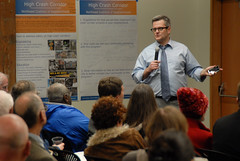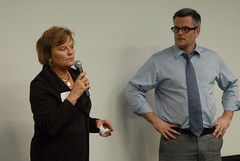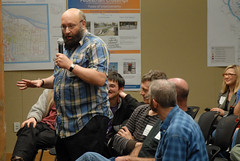Mayor Sam Adams hosted the Transportation Safety Summit at U of O’s White Stag Building in downtown Portland Tuesday night and a standing-room only crowd of over 200 citizens, advocates and city and state officials showed up.
The event offered an opportunity (albeit short at only two hours) to network, learn about Portland’s transportation safety concerns, and share feedback about how the City should, according to the Mayor’s official invite, “close the gap between the current state of traffic safety in Portland and the desired state.”
“…If we are going to meet that goal of 25% mode share — and for all of you, sort of transportation groupies, that mode share feels good… We’re going to have to work at it.”
— Sue Keil, Director of PBOT
Speaking at the event were Mayor Adams, PBOT Director Sue Keil, Police Chief Rosie Sizer, ODOT Region 1 Director Jason Tell, TriMet GM Fred Hansen, Traffic Division Captain Eric Hendricks Portland Fire Marshall Erin Janssens, and others.
Adams, who is also the Transportation Commissioner, spoke about Portland’s accomplishments and ongoing challenges. He shared stats that tell a story of our roads becoming much safer for all modes in recent years, but then warned of complacency. “I share these accomplishments not so we can rest on our laurels, but to show that progress can be made.” Adams re-iterated that although “it has been controversial,” he has chosen to prioritize safety improvements over “smooth pavement.”
We need more money to save lives, said Adams, and thankfully there’s $300 million in new transportation revenue coming into Oregon due to the passage H.B. 2001 (although Adams said there’s a petition effort afoot to challenge that law). Regardless of budgets, Adams said PBOT relies on partnerships with agencies and citizen groups. “They’re important and they make a difference.”
While Adams’ tone on getting more Portlanders to choose bicycles is hopeful and inspiring, PBOT Director Sue Keil — the person in Portland with the most power to carry out Adams’ vision — has a different tone. After sharing the party line about the importance of safe biking and walking routes for everyone, she spoke about the “serious choices” she has had to make in terms of spending priorities.
Referring to a series of public meetings held prior to last year’s budget talks (at a time when PBOT revenue was in much more dire straits than it is now), she said PBOT has “walked away from residential streets” and instead is focused on “the busy streets, the lifeline routes that carry goods and services to commercial centers.” Below is a partial transcript of the rest of her remarks:
“…If we are going to meet that goal of 25% mode share — and for all of you, sort of transportation groupies, that mode share feels good. But, if we’re going to get to 25% of trips in the next 20 years by bicycle — we’re going to have to work at it. And it’s not just about putting infrastructure out there, although that certainly helps, it is about encouragement and education and getting people who are like me; not the hot-rod teenage male that is the classic, sort of poster child in bicycling… It’s about getting folks to use those bicycle boulevards which are much safer and will really increase the number of people who are cycling.”
It remains to be seen how Keil will balance her priority on “busy streets” while also improving bike boulevards — which are on the same residential streets her bureau has “walked away from,” and that she says are so key to getting people like her on a bike and reaching the 25% mode split goal. Keil also seemed to lament PBOT’s lost revenue due to 100,000 fewer cars being registered in Multnomah County last year — a trend that should be encouraged and celebrated for someone committed to increasing bike mode split.
TriMet GM Fred Hansen’s remarks included a reference to a key safety issue that remains to be solved — the bike/bus leapfrog that happens on streets like North Williams. “Our buses are in direct conflict… with bike lanes. How do we do that [service bus stops] and still be safe.” Hansen said they’re working to identify the top 12 bike-bus conflict locations.
Hansen also shared a troubling stat: 25% of seniors and riders with disabilities cannot access TriMet’s services due to an absence of sidewalks and/or unsafe crossings.
This was the first time I’ve seen the Portland Fire Marshall attend a transportation event. Mayor Adams knows the Fire Bureau is a key player on bike projects. They have final veto power (and have used it in the past) and they figure prominently in bike boulevard plans because some of the traffic calming measures PBOT staff prefer are not welcomed by emergency vehicle operators. Janssens weighed in on that issue: “Our goals have been directly opposed in the past… How do we meet our response time goals and still provide safe routes for bikes?”
After these introductory speeches, attendees broke off into groups according to geographic area. The groups were separated into Portland’s nine neighborhood coalitions and each coalition station had four focus areas; Safe Routes to School, bike safety, pedestrian safety, and high-crash corridors. Each area was staffed with a City employee to explain the issues, answer questions, and write down feedback.
The neighborhood focus stations were buzzing with activity. Citizens could view a map of crash locations and stick post-it notes with their feedback: “There is no reasonable place to get across the highway,” “MLK is very scary,” “Easier crossings of NE 33rd please.”
One person didn’t need a post-it note to make their point. On the crash location map, right on top of the MLK/Grand/Broadway corridor which was nearly solid red with crash incidents, someone had simply drawn a sad face.
In the Southwest Neighborhood section, citizen activist Don Baack told a city staffer that he’d like to see more communication between PBOT and residents before decisions are made.
With all the great discussions happening, it seemed like the event should have ended with everyone reporting back with key insights from their neighborhoods. But instead, the night ended with a short Q & A session.
The first question was about why the City should raise revenue by licensing bikes. Adams replied by saying, “We’ve looked at that a number of times” but that it doesn’t pencil out financially. “It’s not the big money-maker you might expect… it’s not a panacea.” He also pointed out that “Bikes are paying their fare share.”
The next question went to a man who is legally blind. He said some of his friends are “fearful to go out” because they’re afraid someone on a bike will run them over. “Bicyclists have to have some incentive to respect pedestrians,” he said.
North Portland resident and member of the City’s bike advisory committee Shamus Lynskey asked: “What’s the next big idea for how to fund all of these great ideas?” Neither Mayor Adams (who mentioned his effort to find $20 million for bike boulevards in the Bureau of Environmental Services budget) or PBOT Director Sue Keil (who mentioned a pilot VMT tax program) had much of an answer for that one.
Overall, attendees seemed grateful for the event, but it’s clear that these issues deserve much more attention. Hopefully Mayor Adams will share the results of all the neighborhood feedback and provide details on how/if he and PBOT plan to address all the citizen feedback. There was also survey launched prior to this event that was not talked about at the Summit. I’ve asked the Mayor’s Office for results of that and will share them once they become available.





